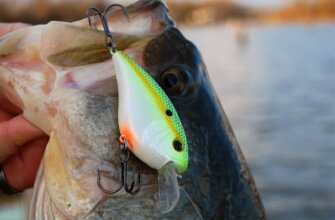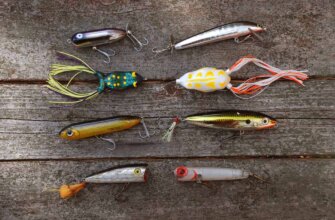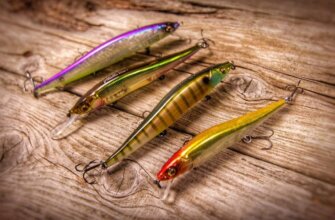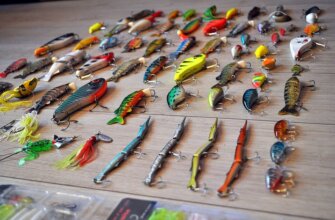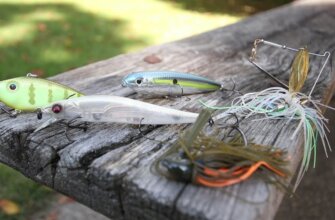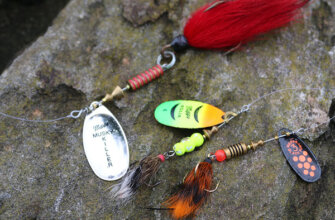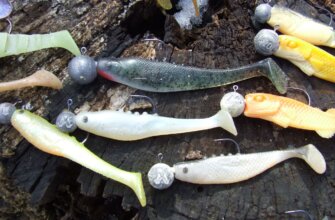Trout fishing is a popular recreational activity enjoyed by many anglers around the world. Trout are known for their elusive nature, challenging fishing conditions, and remarkable fighting abilities, making them an exciting species to pursue.
When it comes to trout fishing, there are numerous effective lures you can use. The best lure for trout can vary depending on factors such as the location, time of year, and personal preference. However, here are some popular and widely used trout lures:
- Spinners: Spinners like Mepps Aglia, Panther Martin, and Blue Fox Vibrax are great choices. They have a spinning blade that creates flash and vibrations, attracting trout.
- Spoon lures: Spoons such as Thomas Buoyant, Acme Kastmaster, and Daredevle are productive for trout. They imitate injured baitfish and can be cast long distances.
- Crankbaits: Floating or diving crankbaits in trout patterns can be effective, especially in larger bodies of water. Rapala Original Floating and Rebel Tracdown Minnow are popular options.
- Soft plastic baits: Trout can be enticed by soft plastic baits, such as trout worms, grubs, and minnow imitations. Brands like Berkley PowerBait, Gulp! Alive, and Zoom Flukes are worth trying.
- Fly fishing lures: If you’re into fly fishing, a variety of fly patterns can work well for trout. Examples include Woolly Buggers, Elk Hair Caddis, Adams Parachute, and Pheasant Tail Nymphs.
10 best trout lures
Here are 10 popular trout lures that many anglers consider effective:
- Mepps Aglia Spinner. A classic spinner with a spinning blade that creates flash and vibrations to attract trout.
- Panther Martin Spinner. Another popular spinner known for its enticing action and ability to attract trout in various water conditions.
- Blue Fox Vibrax Spinner. This spinner combines a vibrating blade and a free-turning brass body to produce lifelike movements and attract trout.
- Rooster Tail Spinner. A versatile spinner that imitates small baitfish and insects, making it effective for trout in different situations.
- Rapala Original Floating Minnow. A floating crankbait that mimics injured baitfish, often triggering aggressive strikes from hungry trout.
- Rebel Tracdown Minnow. A diving crankbait that dives to specific depths, allowing you to target trout at different levels in the water column.
- Berkley PowerBait Trout Worm. A soft plastic worm infused with scent that can be deadly when rigged on a small hook and fished on the bottom or with a float.
- Thomas Buoyant Spoon. A popular spoon lure that has a wobbling action and flashes underwater, attracting trout from a distance.
- Woolly Bugger Fly. An effective fly pattern that imitates various aquatic insects and small baitfish. It’s versatile and can be fished in different ways.
- Adams Parachute Dry Fly. A classic dry fly pattern that imitates mayflies and other insects on the water’s surface. It’s effective during insect hatches when trout are rising to feed.
Mepps Aglia Spinner
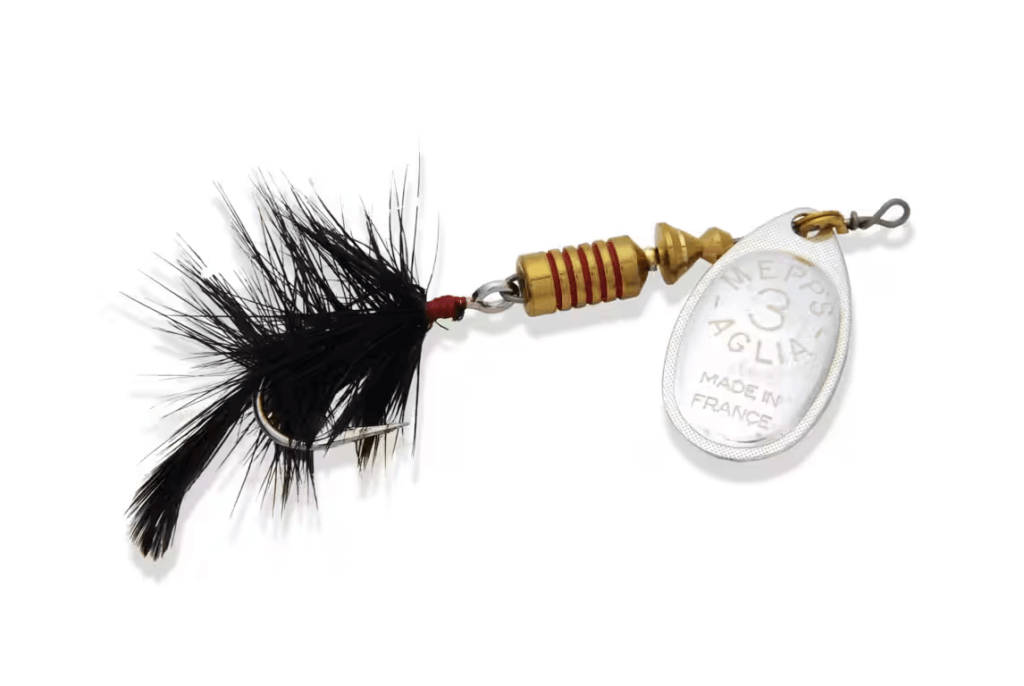
The Mepps Aglia Spinner is a popular and effective lure for targeting trout. It is known for its simple yet highly effective design, which has been proven to entice strikes from various trout species in different fishing conditions.
The Aglia Spinner features a spinning blade, which is the key component responsible for attracting trout. The blade creates flash and vibration in the water, mimicking the movements of a small fish or insect and grabbing the attention of nearby trout. The spinning action also helps to imitate the natural prey of trout, making it an enticing target for them to strike.
The lure is available in different blade sizes and colors, allowing anglers to match the local baitfish or insects that trout are feeding on. Bright and flashy blade colors such as silver, gold, or chartreuse are often effective in attracting trout, especially in clear water conditions. Natural or more subtle colors like black, brown, or olive can be successful in imitating specific prey items or when fishing in more heavily fished waters.
The Aglia Spinner is designed to be versatile and can be fished in various ways. It can be cast and retrieved, allowing the blade to spin and create flash and vibration as it moves through the water. This method is particularly effective when targeting active trout or covering a larger area. The lure can also be trolled behind a boat or drifted in a river current to cover more water and increase the chances of encountering trout.
When fishing with the Aglia Spinner, it is important to vary the retrieval speed and depth to find what triggers the most strikes. Some days, trout may prefer a slow and steady retrieve, while on other days, a faster and erratic retrieve may be more effective. It’s also worth experimenting with pauses and twitches during the retrieve to imitate the movements of injured or fleeing prey, which can often trigger aggressive strikes from trout.
The Aglia Spinner’s design incorporates a single or treble hook, depending on the model, to increase hooking potential when a trout strikes. It is important to ensure that the hook is sharp and in good condition to maximize hook-up rates. If fishing in areas with snaggy or weedy bottoms, anglers can opt for models with a single hook to minimize snagging and increase the chances of landing trout.
| Advantages | Disadvantages |
| Versatility: The Mepps Aglia Spinner is versatile and can be used in various fishing environments, including rivers, streams, and lakes. It can effectively target different species of trout, including rainbow trout, brown trout, and brook trout. Attractive Flash and Vibration: The Aglia Spinner features a spinning blade that creates flash and vibration in the water. This combination of visual and sensory attraction can trigger the predatory instincts of trout, enticing them to strike the lure. Wide Range of Sizes and Colors: The Mepps Aglia Spinner is available in a wide range of sizes and colors, allowing anglers to match the hatch or experiment with different patterns. This versatility enables anglers to adapt to changing fishing conditions and trout preferences. Long Casting Distance: The weight and aerodynamic design of the Aglia Spinner allow for long casting distances. This is particularly advantageous when targeting trout in larger bodies of water or when trying to reach distant areas. Effective in Various Retrieval Speeds: The Aglia Spinner can be retrieved at different speeds, allowing anglers to experiment and find the most effective presentation. Slow retrieves can imitate injured or slow-moving prey, while faster retrieves can simulate a fleeing baitfish. | Snagging and Hang-ups: The treble hook on the Aglia Spinner can sometimes lead to snagging and hang-ups, especially when fishing in areas with heavy cover, such as submerged logs or dense vegetation. This can result in lost lures and frustration. Limited Depth Range: The Aglia Spinner is primarily a surface or near-surface lure and may not effectively target trout that are holding at deeper depths. It is best suited for shallow-water or mid-water column fishing. Susceptible to Line Twist: Due to the spinning blade, the Aglia Spinner can cause line twist, especially if the line is not properly managed or if the retrieve speed is too fast. Line twist can decrease casting distance and result in tangles. |
Panther Martin Spinner
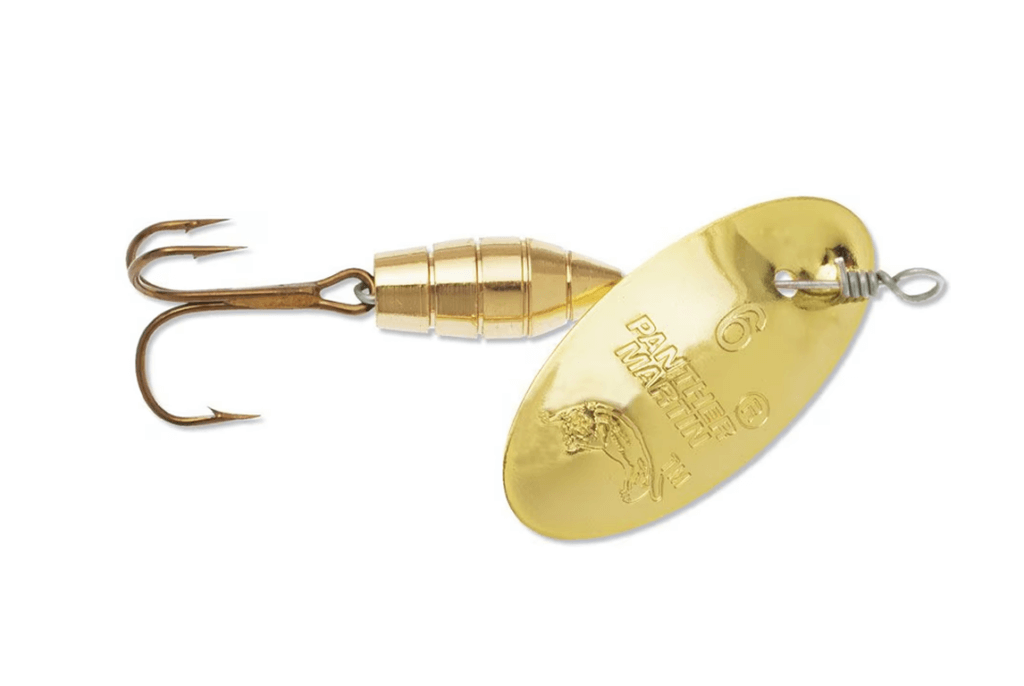
The Panther Martin Spinner is a classic and reliable lure that has long been favored by anglers for trout fishing. Its simple yet effective design, along with its proven track record of attracting trout, makes it a popular choice among both beginners and experienced anglers.
The Panther Martin Spinner features a weighted body and a spinning blade. The blade creates flash and vibration as it spins through the water, imitating the movements of a small fish or insect and catching the attention of trout. The spinning action also triggers the predatory instincts of trout, enticing them to strike.
The lure is available in different sizes and a variety of blade colors and patterns. The blade colors range from bright and flashy options like silver, gold, or chartreuse to more natural or subdued colors like black, brown, or olive. Anglers can select the blade color and pattern based on the prevailing water conditions and the trout’s feeding preferences.
One of the advantages of the Panther Martin Spinner is its versatility in fishing techniques. It can be cast and retrieved at various speeds to imitate different prey movements, such as a fast-swimming fish or a struggling insect. Anglers can experiment with different retrieval speeds and pauses to find the most effective presentation for enticing trout.
The lure is also effective when fishing in moving water, such as streams or rivers. The current helps to create additional movement and vibration in the lure, making it even more enticing to trout. When fishing in rivers, anglers can cast slightly upstream and allow the Panther Martin Spinner to drift naturally downstream, covering different areas where trout may be hiding or feeding.
The Panther Martin Spinner is designed with a single hook, often with a treble hook as an option, to increase hooking potential when a trout strikes. It is important to ensure that the hook is sharp and in good condition to improve hook-up rates. The single hook design also helps reduce the chances of snagging in weedy or rocky areas, increasing the likelihood of landing trout.
| Advantages | Disadvantages |
| Irresistible Action: The Panther Martin Spinner features a unique spinning blade design that creates a pulsating action in the water. This action mimics the movement of a wounded baitfish, attracting the attention of trout and triggering aggressive strikes. Versatility: The Panther Martin Spinner can be used in various fishing environments, including rivers, streams, and lakes. It is effective for targeting different species of trout, such as rainbow trout, brown trout, and brook trout. Easy to Use: The Panther Martin Spinner is easy to use, making it suitable for anglers of all skill levels. It can be cast and retrieved at a steady speed or with intermittent pauses to vary the presentation and entice trout to strike. Wide Range of Sizes and Colors: The Panther Martin Spinner is available in a wide range of sizes and colors, allowing anglers to match the hatch or experiment with different patterns. This versatility enables anglers to adapt to specific fishing conditions and trout preferences. Long Casting Distance: The weight and aerodynamic design of the Panther Martin Spinner enable long casting distances. This is particularly advantageous when targeting trout in larger bodies of water or when trying to reach distant areas. | Limited Depth Range: The Panther Martin Spinner is primarily a surface or near-surface lure and may not effectively target trout that are holding at deeper depths. It is best suited for shallow-water or mid-water column fishing. Snagging and Hang-ups: The treble hook on the Panther Martin Spinner can sometimes lead to snagging and hang-ups, especially when fishing in areas with heavy cover, such as submerged logs or dense vegetation. Care should be taken to avoid obstacles and minimize the risk of losing the lure. Susceptible to Line Twist: Due to the spinning blade, the Panther Martin Spinner can cause line twist, especially if the line is not properly managed or if the retrieve speed is too fast. Line twist can decrease casting distance and result in tangles. |
Blue Fox Vibrax Spinner
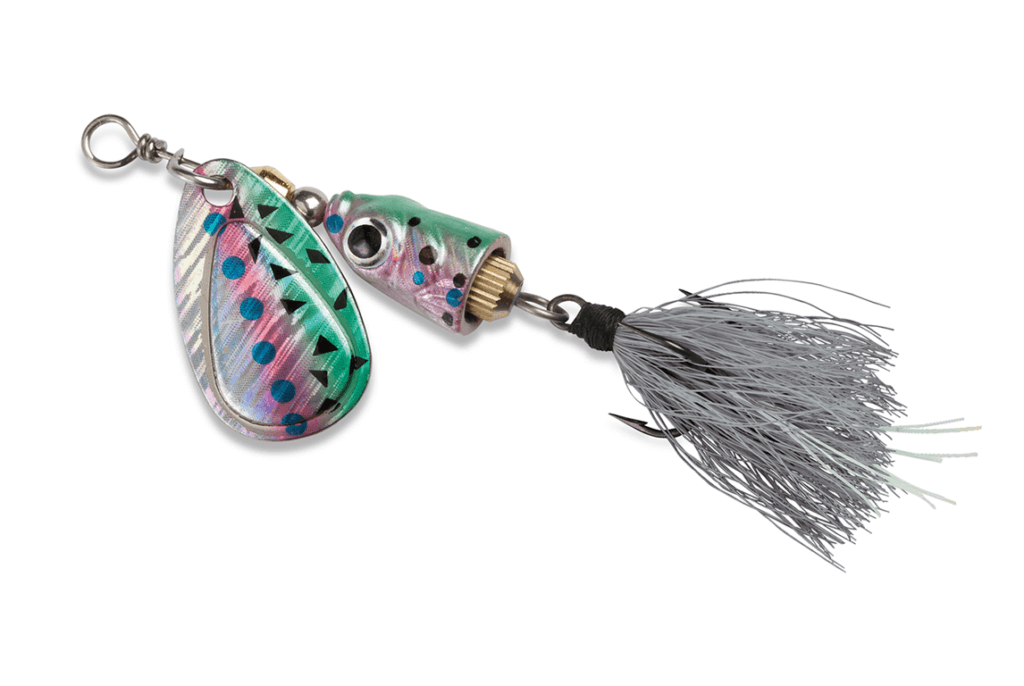
The Blue Fox Vibrax Spinner is a popular and reliable lure choice for trout fishing. Its unique design and effective fish-attracting features make it a go-to option for many anglers targeting trout.
The Vibrax Spinner features a spinning blade, a vibrant colored body, and a weighted design. The blade spins rapidly as it moves through the water, creating flash and vibration that mimic the movements of a small fish or fleeing prey. The combination of visual attraction and vibrational signals makes it highly enticing to trout, triggering their predatory instincts and enticing them to strike.
The lure is available in various sizes, allowing anglers to match the hatch and imitate the specific baitfish or insects that trout are feeding on. Additionally, the Vibrax Spinner offers different blade colors and patterns to cater to different water and light conditions. Bright and flashy blade colors like silver, gold, or chartreuse are effective in attracting trout’s attention, especially in clear water or bright conditions. Natural or more subdued blade colors like brown, black, or olive can be successful in imitating specific prey species or when fishing in low-light or murky waters.
The Vibrax Spinner is designed for versatile fishing techniques. It can be cast and retrieved at various speeds, allowing anglers to experiment with different retrieval styles to trigger strikes from trout. A steady and consistent retrieve can imitate the swimming motion of a small fish, while a stop-and-go retrieve with occasional twitches can mimic the movements of injured or fleeing prey.
When fishing with the Vibrax Spinner, it’s essential to vary the depth and presentation to increase your chances of success. Trout often feed at different water depths, so adjusting the retrieval speed and depth can help you target trout at their preferred feeding zones. Additionally, consider the water conditions and adapt your fishing approach accordingly. In clear or calm water, a more subtle presentation may be effective, while in faster or turbid waters, a more aggressive and attention-grabbing retrieve can yield better results.
The Vibrax Spinner is typically equipped with a single hook, which helps reduce snagging and simplifies unhooking trout. However, some models offer an additional trailing treble hook for increased hooking potential. It’s essential to ensure the hooks are sharp and in good condition to maximize hook-up rates.
| Advantages | Disadvantages |
| Flash and Vibration: The Blue Fox Vibrax Spinner features a spinning blade that creates flash and vibration in the water. This combination of visual and sensory attraction can be highly effective in enticing trout to strike, especially in stained or murky water conditions. Versatility: The Blue Fox Vibrax Spinner is a versatile lure that can be used in various trout fishing environments, including rivers, streams, and lakes. It is effective for targeting different species of trout, such as rainbow trout, brown trout, and brook trout. Wide Range of Sizes and Colors: The Blue Fox Vibrax Spinner is available in a wide range of sizes and colors, allowing anglers to match the hatch or experiment with different patterns. This versatility enables anglers to adapt to specific fishing conditions and trout preferences. Easy to Use: The Blue Fox Vibrax Spinner is easy to use, making it suitable for anglers of all skill levels. It can be cast and retrieved at a steady speed or with intermittent pauses to vary the presentation and trigger trout strikes. Long Casting Distance: The weight and aerodynamic design of the Blue Fox Vibrax Spinner enable long casting distances. This is particularly advantageous when targeting trout in larger bodies of water or when trying to reach distant areas. | Limited Depth Range: The Blue Fox Vibrax Spinner is primarily a surface or near-surface lure and may not effectively target trout that are holding at deeper depths. It is best suited for shallow-water or mid-water column fishing. Treble Hook Size: The treble hook on the Blue Fox Vibrax Spinner is relatively small, which can make it more difficult to hook and land larger trout. It may be necessary to upgrade the hook size for targeting larger trout or in situations where trout have a tendency to nip at the lure without getting fully hooked. Snagging and Hang-ups: The treble hook on the Blue Fox Vibrax Spinner can sometimes lead to snagging and hang-ups, especially when fishing in areas with heavy cover, such as submerged logs or dense vegetation. Care should be taken to avoid obstacles and minimize the risk of losing the lure. |
Rooster Tail Spinner
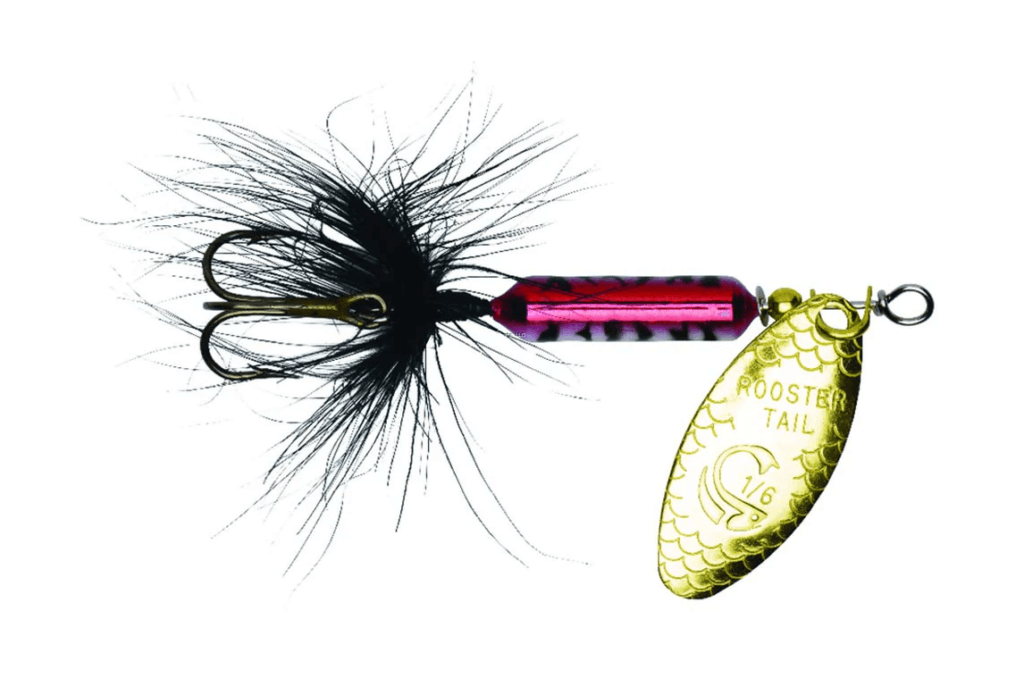
The Rooster Tail Spinner is a well-known and effective lure for trout fishing. Its combination of a spinning blade, colorful body, and enticing action make it a go-to choice for many anglers targeting trout.
The Rooster Tail Spinner features a spinning blade at the front, which creates flash and vibration as it rotates through the water. This mimics the movement of a small fish or insect, attracting the attention of trout and triggering their predatory instincts. The spinning blade also helps to make the lure more visible, especially in murky or stained water conditions.
The lure is available in a variety of sizes, allowing anglers to match the hatch and imitate the specific baitfish or insects that trout are feeding on. Additionally, it offers a wide range of colors and patterns to choose from, including bright and vibrant options like chartreuse, orange, or firetiger, as well as more natural and subtle hues like brown, black, or olive. The color selection can be adjusted based on water clarity, light conditions, and the trout’s preferences.
One of the advantages of the Rooster Tail Spinner is its versatility in fishing techniques. It can be cast and retrieved at various speeds, allowing anglers to imitate different types of prey movement. A slow and steady retrieve can mimic a small fish swimming, while a faster retrieve can imitate a fleeing or injured baitfish. Anglers can experiment with different retrieval speeds and pauses to find the most effective presentation for enticing trout.
The Rooster Tail Spinner is particularly effective when fishing in streams, rivers, or lakes with moving water. The current helps to add additional action to the lure, making it even more enticing to trout. Anglers can cast slightly upstream and allow the Rooster Tail Spinner to drift naturally downstream, covering different areas where trout may be holding or feeding.
The lure is typically equipped with a single hook, which helps reduce the chances of snagging and makes it easier to unhook trout. However, some models may also feature an additional treble hook for increased hooking potential. It’s important to ensure that the hooks are sharp and in good condition to improve hook-up rates.
| Advantages | Disadvantages |
| Versatility: The Rooster Tail Spinner is a versatile lure that can be effective in various trout fishing environments, including rivers, streams, and lakes. It can imitate a wide range of prey items, such as small fish, insects, or aquatic invertebrates, making it suitable for different trout species. Flash and Vibration: The spinning blade of the Rooster Tail Spinner creates flash and vibration in the water, which can attract the attention of trout and trigger strikes. The combination of visual and sensory appeal makes it highly effective, especially in clear or slightly stained water conditions. Easy to Use: The Rooster Tail Spinner is easy to use, making it suitable for anglers of all skill levels. It can be cast and retrieved at various speeds to imitate different types of prey movements or to match the activity level of the trout. Wide Range of Sizes and Colors: The Rooster Tail Spinner is available in a wide range of sizes and colors, allowing anglers to match the hatch or experiment with different patterns. This versatility enables anglers to adapt to specific fishing conditions and trout preferences. Long Casting Distance: The weight and design of the Rooster Tail Spinner allow for long casting distances. This can be advantageous when targeting trout in larger bodies of water or when trying to reach areas that are difficult to access. | Limited Depth Range: The Rooster Tail Spinner is primarily a surface or near-surface lure, and it may not effectively target trout that are holding at deeper depths. It is best suited for shallow-water or mid-water column fishing. Treble Hook Size: The Rooster Tail Spinner is equipped with a treble hook, which can sometimes lead to issues such as hooking trout deeply or causing damage to the fish. Care should be taken when handling trout caught on treble-hooked lures to minimize harm and ensure proper catch-and-release practices. Snagging and Hang-ups: The treble hook on the Rooster Tail Spinner can be prone to snagging and hang-ups, especially when fishing in areas with heavy cover or structure. Anglers should be mindful of their surroundings and retrieve the lure with care to avoid unnecessary snags and potential loss of the lure. |
Rapala Original Floating Minnow
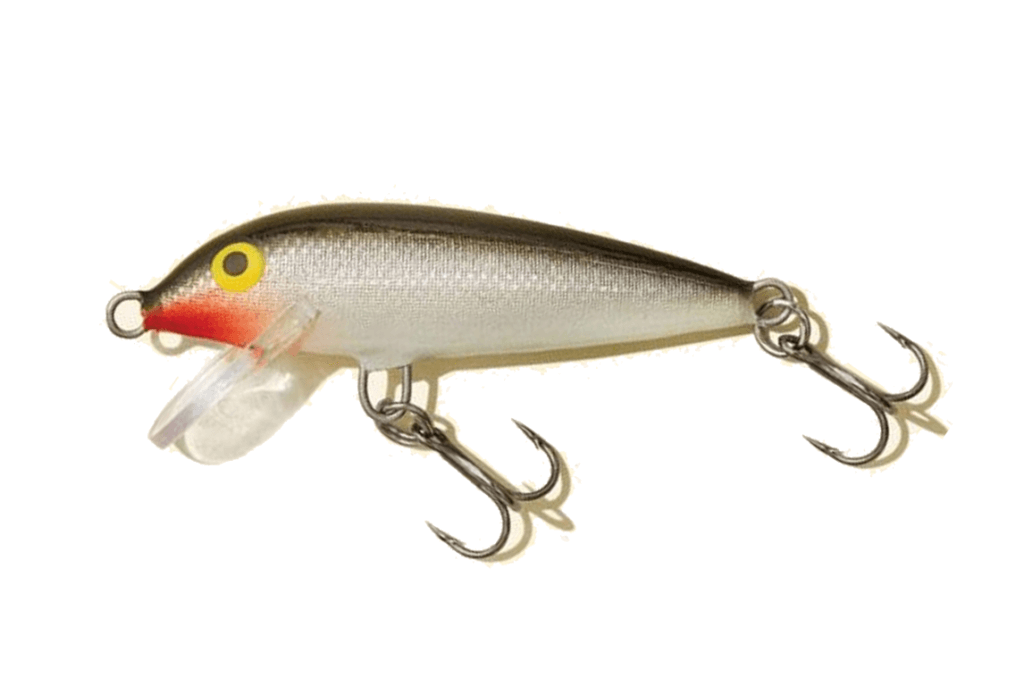
The Rapala Original Floating Minnow is a classic and highly effective lure for trout fishing. Its realistic appearance, lifelike swimming action, and versatility make it a popular choice among anglers.
The Original Floating Minnow is designed to imitate a wounded or struggling baitfish, which is a natural prey for trout. It features a realistic body shape, detailed finishes, and 3D eyes that give it an authentic look in the water. The lure is available in various sizes, allowing anglers to match the size of the baitfish that trout are feeding on.
One of the key features of the Original Floating Minnow is its buoyancy. It is designed to float at rest, which allows anglers to achieve a variety of fishing techniques. The lure can be cast and retrieved, twitched, or jerked to create a lifelike swimming motion that entices trout to strike. The buoyancy also allows for pauses and suspending actions, mimicking the behavior of injured or vulnerable prey.
When fishing with the Original Floating Minnow, it’s important to consider the water conditions and adjust your presentation accordingly. In clear water, a more natural and subtle color pattern may be effective, while in stained or murky water, brighter and more vibrant colors can help attract trout’s attention. The lure’s wobbling and rolling action combined with its flash can trigger aggressive strikes from trout, especially in areas with current or structure where trout are likely to ambush their prey.
The Original Floating Minnow is a versatile lure that can be used in various fishing situations. It can be effective in streams, rivers, lakes, and even ponds where trout reside. Anglers can target different water depths by adjusting the retrieval speed and using different sizes of the lure. Slow and steady retrieves imitate the movements of a swimming fish, while occasional twitches or pauses can mimic a wounded or struggling baitfish.
The lure is typically equipped with two treble hooks, which offer a higher chance of hooking trout when they strike. It’s important to ensure that the hooks are sharp and in good condition to increase hook-up rates and reduce the chances of fish shaking loose during the fight.
| Advantages | Disadvantages |
| Realistic Action: The Rapala Original Floating Minnow is designed to mimic the swimming action of a wounded or distressed baitfish. Its subtle side-to-side wobble and darting movements in the water can be highly enticing to trout and trigger strikes. Versatility: The Original Floating Minnow can be used in various trout fishing environments, including rivers, streams, and lakes. It is effective for both stillwater and moving water situations, making it a versatile choice. Natural Appearance: The lure’s realistic design and color patterns imitate the appearance of natural prey, making it more appealing to trout. The lifelike finish and attention to detail contribute to its effectiveness. Long Casting Distance: The weight distribution of the Original Floating Minnow allows for long and accurate casting, which can be advantageous when trout are positioned at a distance or in areas that are challenging to reach. Quality Construction: Rapala lures are known for their high-quality construction and durability. The Original Floating Minnow is built to withstand the rigors of fishing and is capable of lasting a long time with proper care. | Limited Depth Range: The Rapala Original Floating Minnow is primarily a shallow-water lure and is most effective when fished near the surface or in shallow to mid-water depths. It may not be as effective for targeting trout holding at deeper depths. Treble Hook Size: The lure is equipped with treble hooks, which can sometimes lead to deep hook sets or cause harm to the fish. Anglers should handle trout caught on treble-hooked lures with care and practice proper catch-and-release techniques. Susceptible to Snags: The exposed treble hooks on the lure can be prone to snagging and getting caught on vegetation, rocks, or other underwater obstacles. Fishing in areas with heavy cover or structure may increase the risk of losing the lure. |
Rebel Tracdown Minnow
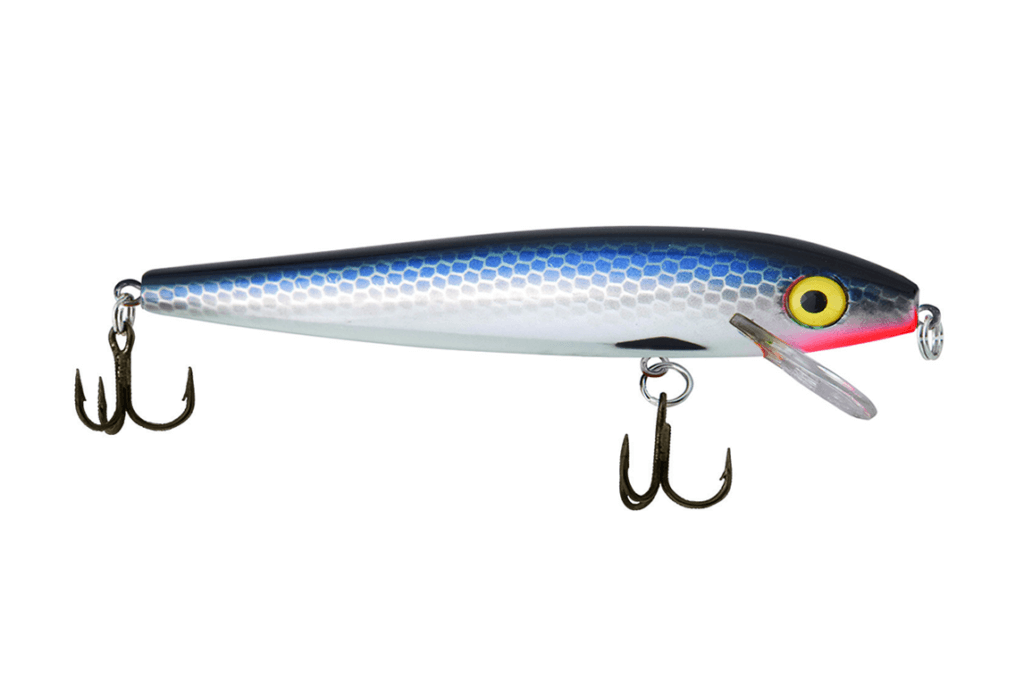
The Rebel Tracdown Minnow is a highly effective lure for trout fishing. It is specifically designed to target trout in deeper water or when they are holding at different depths in the water column.
The Tracdown Minnow features a slender and streamlined body shape that mimics the profile of a small baitfish. It is available in various colors and finishes to imitate different prey species that trout feed on. The lure is typically equipped with multiple treble hooks, which increase the chances of hooking trout when they strike.
What sets the Tracdown Minnow apart is its sinking ability. It is designed to sink slowly and evenly, allowing anglers to effectively fish at different depths where trout are holding. This makes it a great choice for fishing in deeper pools, channels, or near drop-offs where trout often reside.
To fish the Tracdown Minnow, cast it out and let it sink to the desired depth. The lure can be retrieved with a steady retrieve or with twitches and pauses to imitate the swimming motion of a wounded baitfish. Experimenting with different retrieval speeds and pauses can help trigger strikes from trout. It’s important to vary the retrieve and adapt to the behavior and preferences of the trout on any given day.
When fishing in streams or rivers, it’s advisable to cast slightly upstream and let the Tracdown Minnow drift naturally with the current. This creates a more natural presentation and increases the chances of enticing trout to strike. In lakes or ponds, targeting areas with structure, such as submerged rocks, fallen trees, or weed edges, can be productive as trout often use these areas as ambush points.
The Tracdown Minnow is also effective in different water conditions. In clear water, a more natural and realistic color pattern may be preferred, while in stained or murky water, brighter and more visible colors can help attract trout’s attention.
| Advantages | Disadvantages |
| Realistic Appearance: The Rebel Tracdown Minnow is designed to imitate the natural appearance of baitfish, with realistic color patterns and detailing. This lifelike appearance can attract the attention of trout and increase the likelihood of strikes. Diving Action: The lure is designed to dive and swim at specific depths, allowing anglers to target trout in different water columns. This versatility makes it suitable for various trout fishing situations, including fishing near the surface or deeper in the water. Slow-Sinking Action: The Tracdown Minnow has a slow-sinking action, which can be effective for enticing trout that are holding in deeper water or near the bottom. The slow descent mimics the behavior of injured or dying baitfish, attracting the interest of trout. Durability: The Rebel Tracdown Minnow is known for its durable construction. It can withstand the rigors of fishing, including strikes, toothy trout, and contact with underwater structures. This durability ensures the lure lasts longer, providing good value for money. | Limited Depth Range: While the Rebel Tracdown Minnow offers versatility in terms of diving action, it is limited to specific depths. It may not be suitable for targeting trout that are holding at extremely deep depths or in areas where the lure’s diving depth doesn’t match the trout’s location. Treble Hooks: The lure is typically equipped with treble hooks, which can sometimes lead to deep hook sets or cause harm to the fish. Care should be taken when handling trout caught on treble-hooked lures, and anglers should practice proper catch-and-release techniques to minimize fish injuries. Limited Lure Size Range: The Rebel Tracdown Minnow comes in a limited range of sizes, which may not always match the preferred forage size of trout in specific fishing locations. Matching the size of the lure to the size of the natural baitfish can increase the lure’s effectiveness. Potential for Snags: Like many diving lures, the Rebel Tracdown Minnow has the potential to get snagged on underwater structures, vegetation, or rocks. Fishing in areas with heavy cover or structure may increase the risk of losing the lure. |
Berkley PowerBait Trout Worm
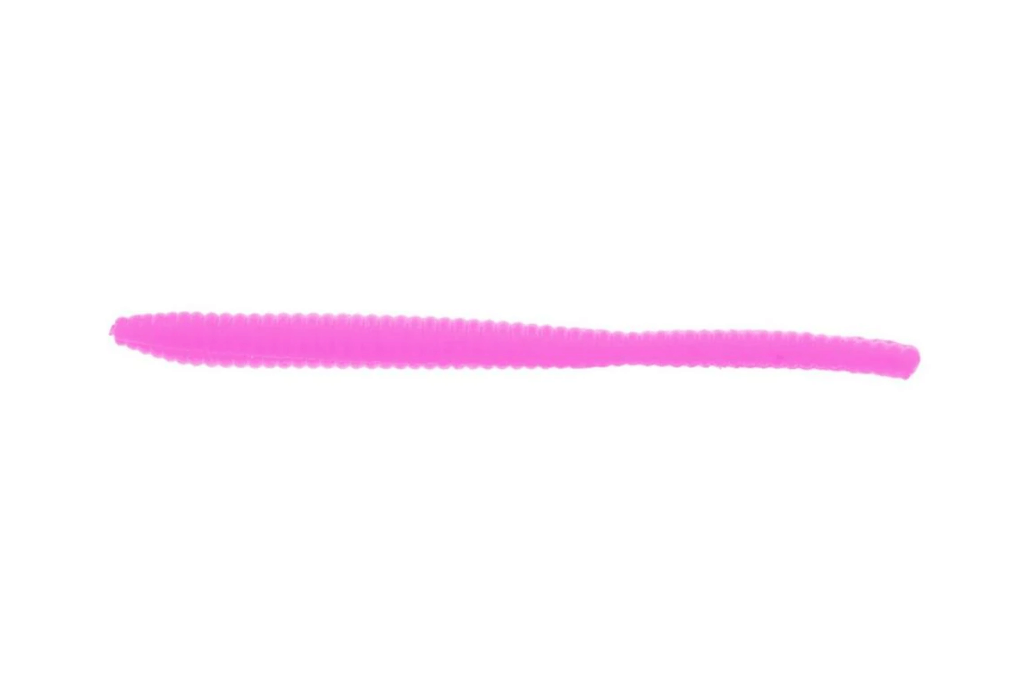
The Berkley PowerBait Trout Worm is a highly effective soft plastic lure designed specifically for trout fishing. It is known for its lifelike appearance and enticing scent that attracts trout and triggers their feeding instincts.
The Trout Worm features a slender and elongated body with a tapered tail, resembling a natural worm or larvae that trout commonly feed on. It is available in a variety of colors, allowing anglers to match the hatch and imitate the prevalent food sources in the water.
One of the key features of the PowerBait Trout Worm is its scent. It is infused with Berkley’s proprietary PowerBait formula, which releases a strong and irresistible scent that trout can detect from a distance. This scent disperses in the water, attracting trout and encouraging them to bite and hold onto the lure longer, increasing hook-up rates.
The Trout Worm can be fished in various ways depending on the fishing conditions and trout behavior. It can be rigged on a light jig head, weighted hook, or fished on a drop shot rig. The versatility of the lure allows anglers to target different water depths and structures where trout are likely to be present.
When fishing with the Trout Worm, a slow and natural presentation is often effective. It can be cast and retrieved with a slow and steady retrieve, allowing the lure to imitate the movement of a worm or larvae. Adding occasional twitches or pauses can also trigger strikes, as it mimics the behavior of a struggling or injured prey.
The PowerBait Trout Worm is particularly effective in streams, rivers, and small lakes where trout feed close to the bottom or in slower-moving currents. It can be cast upstream and allowed to drift naturally with the current, presenting a realistic and enticing offering to trout.
It’s important to note that the Trout Worm’s soft plastic construction makes it very versatile and durable. It can withstand multiple fish strikes and offers good action even at slow retrieval speeds. However, it’s always a good practice to check the condition of the lure regularly and replace it if it becomes too damaged or torn.
| Advantages | Disadvantages |
| Scent and Flavor: The PowerBait Trout Worm is infused with powerful scent and flavor attractants that are designed to mimic natural trout food sources. The scent and flavor help to mask any unnatural odors and entice trout to bite and hold on to the bait longer, increasing your chances of hooking them. Lifelike Action: The soft and supple design of the Trout Worm allows for a natural and lifelike action in the water. The worm wiggles and undulates with even the slightest movement, imitating the movements of real worms or aquatic invertebrates that trout feed on. Versatility: The Trout Worm can be fished in various ways, including rigged on a jig head, under a float, or as part of a drop-shot rig. This versatility allows anglers to adapt to different fishing conditions and target trout in various water depths and structures. Durable: The PowerBait Trout Worm is known for its durability, which means you can catch multiple fish on the same bait without it tearing or losing its effectiveness. This durability translates to better value for money and less time spent re-rigging or replacing baits. | Artificial Appearance: While the PowerBait Trout Worm is designed to imitate natural trout forage, its artificial appearance may not always fool highly selective or wary trout. In such situations, trout may prefer more realistic or natural bait options. Limited Color Range: The Trout Worm is available in a limited range of colors. While the available colors are effective in many situations, there may be times when trout show a preference for specific color patterns that are not available in the PowerBait Trout Worm line. Light Biting Fish: The soft and supple texture of the Trout Worm can sometimes make it difficult to detect light or subtle bites, especially when fishing at longer distances or in windy conditions. Anglers need to pay close attention to their line and rod tip for any signs of a bite. Fish Handling: When using soft plastic baits like the Trout Worm, it’s important to handle the fish with care to minimize stress and potential injury. The soft plastic can sometimes make it more challenging to remove hooks without causing harm to the fish. |
Thomas Buoyant Spoon
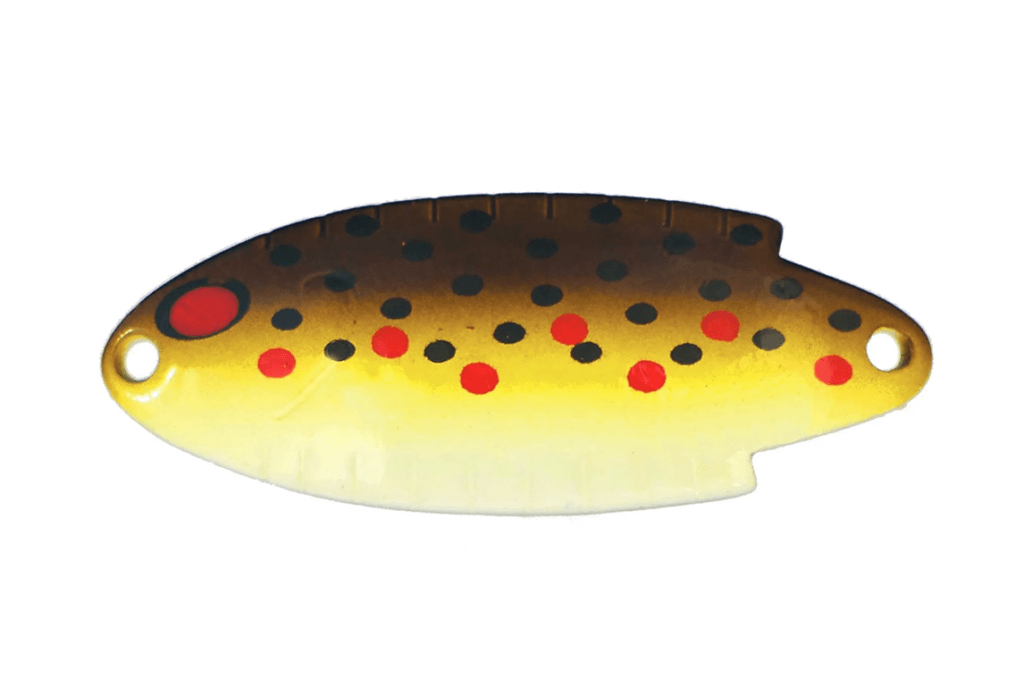
The Thomas Buoyant Spoon is a classic and reliable lure that has been used for trout fishing for many years. It is known for its unique shape and action, which make it highly effective in attracting and enticing trout to bite.
The Buoyant Spoon features a slender, elongated body with a concave shape and a tapered design. It is typically made of solid brass, which provides durability and allows for long and accurate casts. The lure is available in various sizes and colors to match the preferences and feeding patterns of different trout species.
One of the key features of the Buoyant Spoon is its ability to create a vibrant and erratic action in the water. When retrieved, the spoon wobbles and flutters, imitating the movements of a wounded or fleeing baitfish. This action is highly appealing to trout and can trigger aggressive strikes, especially when the lure is presented near their feeding zones or in areas where they are likely to be hiding.
The Buoyant Spoon can be fished using different techniques, depending on the fishing conditions and trout behavior. It can be cast out and retrieved at a steady pace, allowing the spoon to flutter and wobble enticingly. Anglers can also experiment with different retrieval speeds, pauses, and jerks to mimic different baitfish behaviors and trigger reaction strikes from trout.
This spoon lure is particularly effective in rivers and streams, where the current can help enhance its action and attract trout from a distance. It can be cast upstream and allowed to drift downstream naturally, imitating the movement of a disoriented or injured prey. The Buoyant Spoon can also be effective in lakes and ponds, especially when targeting trout near drop-offs, submerged structures, or areas with high fish activity.
The Buoyant Spoon is a versatile lure that can be effective in both shallow and deeper water. Anglers can adjust the retrieve speed and depth by varying the size and weight of the spoon or using additional weight or sinkers if necessary.
| Advantages | Disadvantages |
| Attractive Action: The Thomas Buoyant Spoon has a unique design and shape that allows it to produce an attractive action in the water. It wobbles and vibrates as it’s retrieved, mimicking the movement of a wounded baitfish. This action can trigger aggressive strikes from trout. Versatility: The Buoyant Spoon can be fished in different ways and at various depths. It can be cast and retrieved, trolled, or jigged, making it suitable for different fishing techniques and water conditions. Long Casting Distance: The streamlined shape of the Buoyant Spoon enables it to be cast long distances, allowing anglers to cover more water and reach areas where trout may be holding. Durable Construction: The Thomas Buoyant Spoon is known for its durable construction, typically made of solid brass or other sturdy materials. It can withstand the teeth and aggression of trout, making it a reliable option for repeated use. | Limited Color Selection: The Thomas Buoyant Spoon is available in a limited range of colors compared to some other lures. While the available colors are effective in many situations, there may be times when trout show a preference for specific color patterns that are not offered by the Buoyant Spoon. Single Hook Design: The Buoyant Spoon typically features a single treble hook. While this design is effective in hooking trout, it may also increase the chances of fish coming unhooked during the fight, particularly with larger trout or if they are aggressively striking the lure. Sink Rate: The Buoyant Spoon has a sinking action, meaning it sinks rather than floats or suspends in the water column. This limits its effectiveness in shallow water or when trout are feeding near the surface. Weather Conditions: The Buoyant Spoon may not perform as well in windy conditions or strong currents. Its lightweight design can make it difficult to maintain control and proper depth during retrieval. |
Woolly Bugger Fly
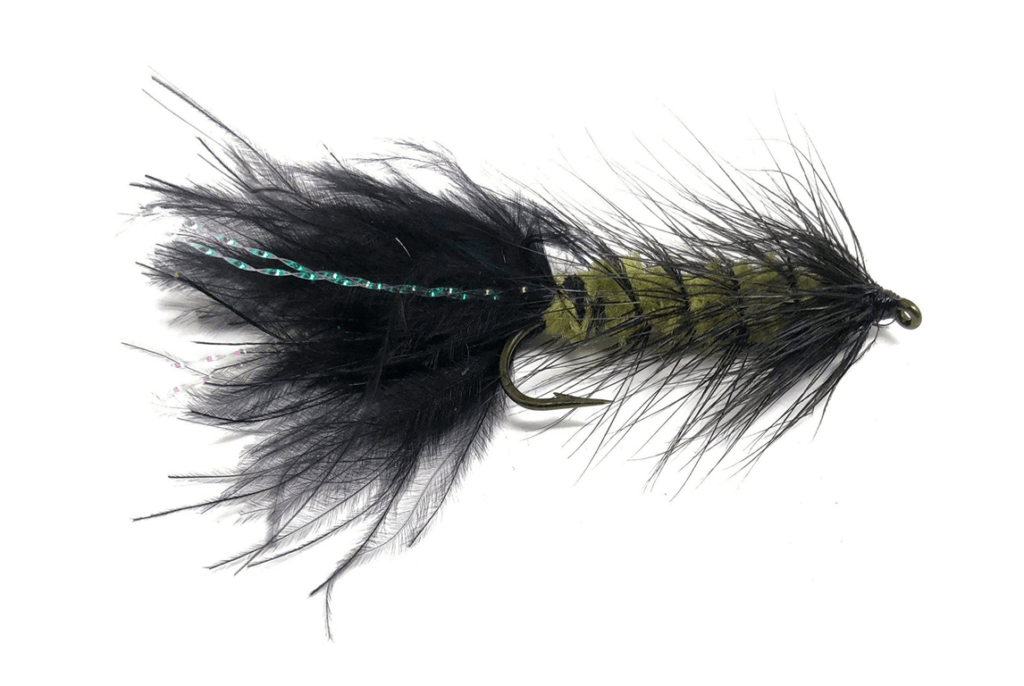
The Woolly Bugger fly is an iconic and versatile fly pattern that is highly effective for trout fishing. It is a popular choice among fly anglers due to its ability to imitate various aquatic insects and small baitfish, making it an enticing meal for trout.
The Woolly Bugger features a body made of chenille or wool, often in dark or natural colors such as black, olive, or brown. It is tied with a marabou or feather tail, which provides lifelike movement in the water. The fly also includes a palmered hackle wrapped around the body, giving it added movement and creating a pulsating effect when retrieved.
This fly can be fished in different ways depending on the fishing conditions and trout behavior. It can be cast upstream and allowed to drift downstream naturally, imitating a drifting insect or baitfish. The Woolly Bugger can also be stripped or retrieved with short, quick pulls, simulating the movement of a fleeing prey. Another effective technique is to let it sink and then retrieve it slowly, mimicking a struggling insect or injured baitfish near the bottom.
The Woolly Bugger is highly versatile and can be used in various trout fishing environments. It is particularly effective in streams, rivers, and lakes where trout feed on a diverse range of food sources. It can imitate mayfly nymphs, damselfly nymphs, leeches, minnows, and even small crayfish, making it a go-to fly for trout feeding on these organisms.
Anglers often experiment with different sizes and colors of the Woolly Bugger to match the hatch or entice trout with contrasting patterns. It can be tied in smaller sizes for targeting smaller trout or in larger sizes for pursuing bigger, more aggressive trout. Some popular color variations include black, olive, brown, and white, but anglers can also explore other color combinations based on local insect and baitfish patterns.
| Advantages | Disadvantages |
| Versatility: The Woolly Bugger is a versatile fly that imitates various aquatic prey such as minnows, leeches, and nymphs. It can be fished in different ways, including dead drifting, stripping, or even as a surface fly, making it suitable for different trout feeding behaviors and water conditions. Attractive Movement: The Woolly Bugger’s marabou and hackle materials create lifelike movement in the water. The pulsating action of the marabou and the undulating motion of the hackle fibers mimic the natural movements of prey, attracting trout and triggering strikes. Easy to Cast: The Woolly Bugger is relatively easy to cast due to its weighted body and streamlined design. It can be cast accurately and over long distances, allowing anglers to cover a wide range of water. Effective in Various Environments: The Woolly Bugger is effective in different types of water, including streams, rivers, lakes, and ponds. It can be used to target trout in both stillwater and moving water, making it a versatile choice for various fishing situations. | Limited Realism: While the Woolly Bugger is a versatile and effective fly pattern, it may not perfectly imitate a specific food source that trout are targeting at a given time. It is a generalist pattern rather than an exact replica, so there may be situations where trout show a preference for a more precise imitation. Potential Snagging: The Woolly Bugger’s streamer-style design with its weighted body and trailing materials can occasionally lead to snagging in underwater structure, vegetation, or debris. This can result in lost flies and frustration for anglers. Fish Catch Rates: Although the Woolly Bugger is known to be effective for trout, its catch rates may vary depending on the specific fishing conditions, trout behavior, and the availability of other natural food sources. There may be times when other fly patterns or techniques outperform the Woolly Bugger. |
Adams Parachute Dry Fly
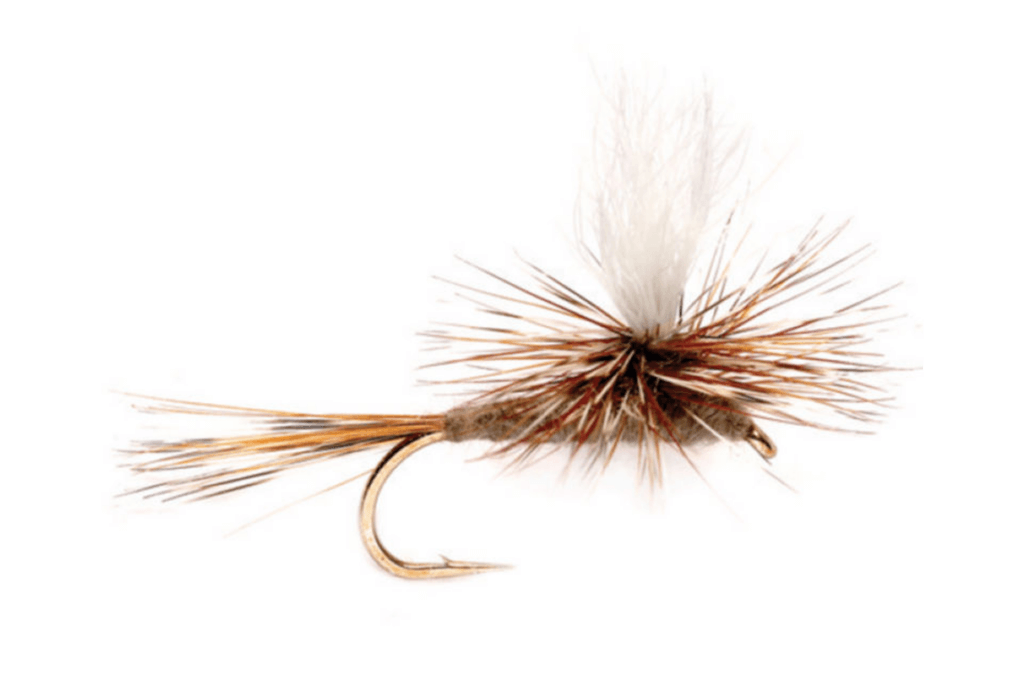
The Adams Parachute Dry Fly is a classic and widely recognized pattern in the world of fly fishing. It is a highly effective fly for trout fishing, known for its versatility and ability to imitate a variety of mayflies and other small insects that trout feed on.
The Adams Parachute features a distinctive design with a hackle that is tied horizontally around a post, giving it a parachute-like appearance. This unique construction allows the fly to sit high on the water’s surface, providing excellent visibility to both anglers and trout. The body of the fly is typically made of dubbed natural or gray-colored fur, imitating the body of various mayfly species.
This dry fly is particularly effective during mayfly hatches, when trout are actively feeding on emerging or adult mayflies on the water’s surface. The Adams Parachute closely resembles the profile and coloration of mayflies, making it an irresistible target for trout. The upright hackle and post also provide excellent buoyancy, allowing the fly to ride high on the water and imitate an insect in a vulnerable position.
The Adams Parachute can be fished using various techniques depending on the situation. It can be cast upstream and allowed to drift naturally downstream, imitating the movement of an emerging or adult mayfly. The fly can also be skated across the surface of the water, imitating a struggling or fluttering insect. It is important to pay attention to the behavior of trout and adjust the presentation accordingly.
This fly is effective in a range of trout fishing environments, including streams, rivers, and stillwaters. It can be used in both fast and slow-moving water, and it excels in calm water where the delicate presentation is crucial. The Adams Parachute is particularly effective when trout are feeding near the surface or in shallow water, and it can produce strikes from both selective and opportunistic trout.
The Adams Parachute is available in different sizes to match the local mayfly species and the feeding preferences of trout. It is also a versatile fly that can be used in different weather conditions and times of the year. It is a reliable choice for trout fishing and a must-have pattern in any angler’s fly box.
| Advantages | Disadvantages |
| Versatility: The Adams Parachute Dry Fly is a versatile pattern that can imitate various mayflies and other small insects. It can be used in different water conditions and at different times of the year when these insects are active. High Visibility: The white parachute post on the fly makes it highly visible on the water, allowing anglers to easily track its drift and detect subtle strikes from trout. Realistic Profile: The Adams Parachute Dry Fly has a realistic silhouette and coloration that closely resembles mayflies, making it appealing to trout. The upright, parachute-style hackle mimics the wings of an emerging or adult insect, adding to its effectiveness. Natural Presentation: When properly presented, the Adams Parachute Dry Fly lands softly on the water’s surface and floats naturally, imitating a real insect. This natural presentation can entice selective trout to rise and strike the fly. | Size Limitations: The Adams Parachute Dry Fly is typically tied in smaller sizes to match the size of natural insects. This can make it challenging to cast and see, especially in windy conditions or fast-moving water. Seasonal Effectiveness: While the Adams Parachute Dry Fly can be effective throughout the year, it may not be the most productive pattern during certain hatches or when trout are keying in on specific insect species. Other patterns may be more successful during these specific times. Floating Ability: Like any dry fly, the Adams Parachute may become waterlogged or lose its ability to float after being repeatedly taken by fish or when exposed to heavy rain. In such cases, the fly may need to be treated with floatant or replaced to maintain its buoyancy. |

